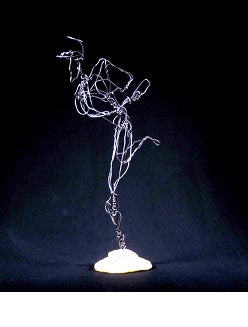| Project IIIH |
Linear Locomotion*
|
| Objectives |
formal: To introduce the studio fundamentals of line and volume. conceptual: To introduce the figure and explore ways it can be expressed three dimensionally. To heighten visual and spatial awareness by limiting the amount of information needed to communicate an idea--to distill a gesture down to its essentials. |
| Project Overview | Using wire, express the movement and balance inherent in an animal or human in motion. |
|
Project References
|
Stewart, Mary, Launching the Imagination: pages 178 - 193. Other References: Muybridge, Eadweard, Animal Locomotion Shaping Space: Wharton Esherik (1.20), Chartres Cathedral (1.33), Hiroshi Teshigahara (1.40), Helio Oiticica (2.3), Christo (2.4), Kenneth Snelson (2.7), John Matt (2.25), Jean Muller, Brottone Bridge (2.32), Max Bill (3.11), Michael Singer (3.12), Mark di Suvero (3.16), Naum Gabo (3.19), Sylvia Stone (4.3), Shiro Kuramata (4.8), Tournament Armor (4.9), Antoine Pevsner (4.25), George Ricky (5.4), Eero Saarinen (5.12, 5.13), Andrea Blum (5.14 and 8.18), Gebruder Thonet (6.2), Lynda Benglis (6.11), Joan Michaels Paque (6.14), Jesus Rafeal Soto (6.3), Alexander Calder (6.4 and 10.10), Pilobolus Dance Theater (6.5), David Hammon (6.20), Toshio Odate (6.21), Poul Henningsen (8.4), Frank Lloyd Wright (8.5), Larry Bell (8.6), Linda Howard (Plate 14 and 8.17), Aiko Miyawaki (8.20), Jose de Riviera (10.6), Simon Rodia (11.15), Norma Minkowitz (12.13), Joyce Scott (12.15), Hiltrud Schaefer (12.16), Edward Livingston (12.21), Carol Hepper (12.26), Georg Jensen (12.27), Liza Lou |
| Vocabulary | line, volume, negative space, positive space, implied line, implied plane, space. |
|
Materials
|
18 and 24 gauge wire, needle nose pliers.
|
|
Process |
Preliminary:
Before coming to class, review the thematic concept of Natural World as found on the website. Also read the discussion Space Frames for Unit III. Review the Project References above. Activities: a) Find or create visual studies of athletes or animals in motion. b) Do a series of expressive or descriptive line drawings of these references in your sketchbook. Where should the greatest density of line occur? Structurally and compositionally, where should heavier wire be used? c) Look at examples of expressive line drawings. This will help connect 2D to 3D approaches to gesture. d) Do not make an exoskeleton of the model but use line to express the posture and tension in the athlete. More wire should be used in areas of extreme torque, muscle, or weight. Less wire should be used in areas of extreme motion. e) Use smaller amounts of wire for details. f) Develop an appropriate base or other mode of presentation for your figure. Considerations: Spend the first day "playing" with the wire. Using the wire, make quick (60 sec.)linear sketches of people in the class as a warm-up. Begin by using pieces of wire no longer than 12 inches. Have one of your colleagues model in front of the class. Repeat this process with 24" wire in the same time frame. Try to convey the shape posture of the whole body. Try to connect two pieces of wire by wrapping one around another without leaving a barb. Timetable: 12-18 hours. |
|
Critique Ideas
|
When you have completed
your sculpture, divide into small groups and exchange artworks with another
group from the class. Within your group, work together to respond to each
sculpture in turn. Consider the following: 2. Point out any personal gestures or techniques the artist used to indicate a particular meaning or sense of identity. 3. Discuss ideas the artwork seems to communicate. After some sharing of interpretations, attempt to state the "message" of the design in one sentence. (This artwork is about. . .) 4. Explain how the forms, techniques, or other elements of the design support its message. |
|
Notebook
|
Your notebook should
include the following: 2. Your design process (drawings, computer-printouts, photos). 3. Supplemental materials (receipts, notes about technique or materials) 4. Documentation of the final work. |

